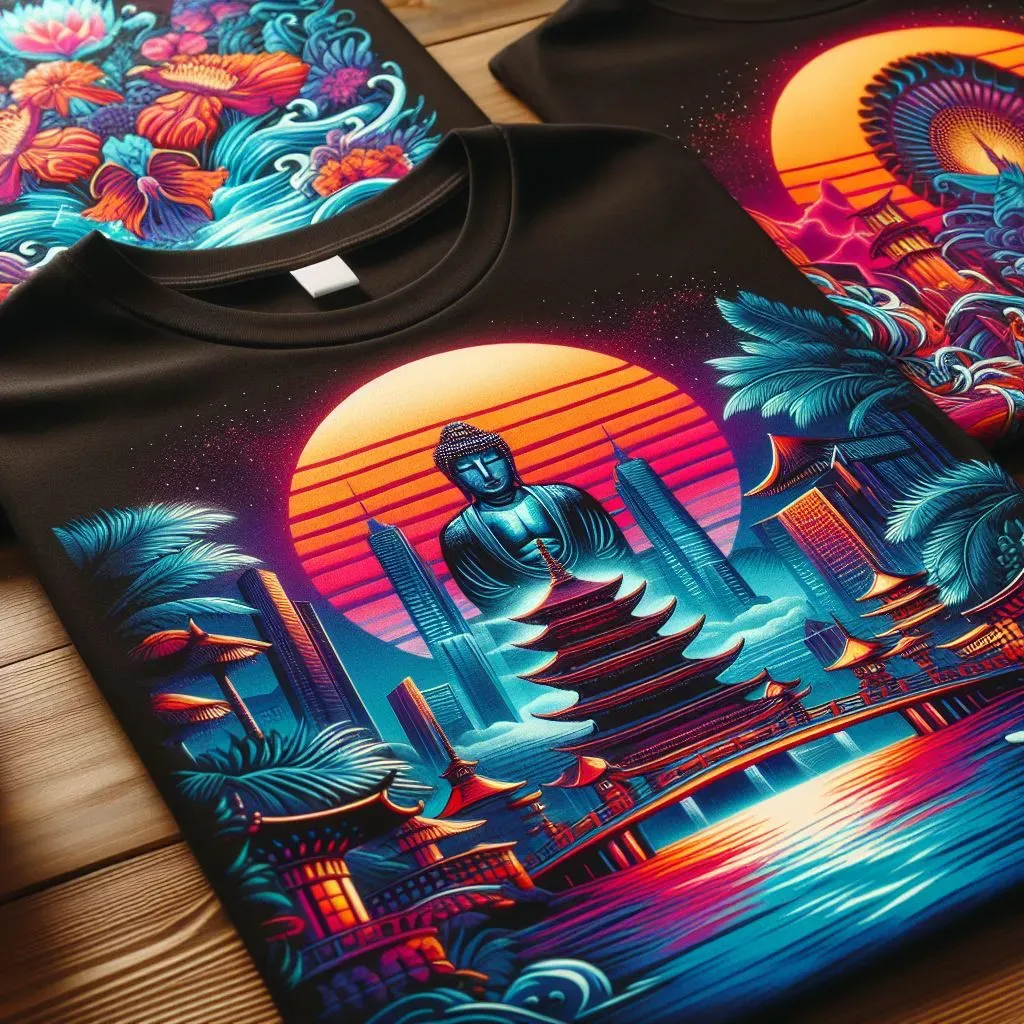Vibrant colors in DTF transfers are essential for creating standout prints that seize attention in the competitive world of custom apparel and merchandise. The explosion of colorful DTF transfers not only enhances the visual appeal of designs but also plays a pivotal role in how products attract customers. Techniques in DTF printing, such as selecting high-quality inks and optimizing heat press settings, are crucial in achieving vibrant colors that last. By leveraging the best inks for DTF and implementing precise temperature control, printers can elevate their outputs significantly. This article will dive into effective strategies for achieving vibrant colors in DTF transfers, ensuring your designs leave a lasting impression.
When discussing the art of vivid hues in Direct to Film (DTF) applications, it’s clear that the foundation of dazzling prints lies in a combination of technical finesse and quality materials. Colorful DTF transfers depend heavily on innovative printing methodologies, where achieving vibrant colors is more than just a goal—it’s an art form. Factors such as appropriate heat press conditions and the right choice of substances greatly impact the final product’s aesthetics and performance. Using top-tier inks specific for DTF also plays a significant role, ensuring that the colors remain striking and true. In the following sections, we will unpack various methods to ensure that your prints deliver unparalleled vibrancy.
The Impact of Quality Inks on DTF Color Vibrancy
In the realm of DTF transfers, the quality of inks directly influences the vibrancy and overall impact of the final product. Using inks that are specifically formulated for DTF applications ensures that the colors will not only be bright but also stable through multiple wash cycles. Studies have shown that inks containing high concentrations of pigment yield richer hues—a crucial factor for those looking to create colorful DTF transfers that stand out in a crowded market.
Additionally, the choice of the best inks for DTF printing cannot be overstated. Printers should seek out brands that are recommended by industry experts for their color accuracy and vibrancy. Investing in top-tier inks may initially seem cost-prohibitive, but the long-term benefits—such as enhanced customer satisfaction and reduced reprints—make it a wise investment for any DTF printing business.
Optimizing Heat Press Settings for Bright and Bold DTF Transfers
The settings used during the heat pressing stage are critical for achieving vibrant colors in DTF transfers. Adhering to precise temperature and pressure guidelines can make a significant difference in how colors appear after the transfer process. Most industry leaders recommend pressing at temperatures between 320°F to 350°F for a period of 10-15 seconds, depending on various factors including material type and ink composition.
Understanding the heat press settings for DTF can prevent common pitfalls, such as dull colors or inadequate adhesion. Too low of a temperature may result in ineffective ink transfer, while excessive pressure might distort the printed design. Implementing the correct settings is fundamental not only to achieve beautiful colors but also to ensure the durability of the print on various fabrics.
Enhancing DTF Transfers with Pre-Treatment Techniques
Pre-treating fabrics prior to applying DTF transfers is essential for achieving the best possible color vibrancy. This process involves applying a specialized solution that enhances the adhesion between the ink and the fabric fibers. Recent advancements in pre-treatment products have shown promising results in maximizing color saturation, allowing printers to create striking and lively DTF transfers.
The importance of pre-treatment cannot be overstated, as it effectively seals in the vibrant colors during the transfer process. A properly prepared surface ensures that the inks bond correctly, resulting in a finished product that exhibits brightness and clarity. By regularly updating and adhering to the latest pre-treatment techniques, printing professionals can stay competitive and consistently produce high-quality DTF outcomes.
The Role of Design Optimization in Achieving Vibrant Colors
Design optimization plays a pivotal role in the creation of dynamic DTF transfers. Ensuring that design files are prepared using the RGB color mode and maintaining a resolution of 300 DPI or higher are crucial steps. These specifications ensure that the colors printed will be as vibrant and true to the original design as possible, thereby enhancing the appeal of the final product.
Ignoring the technical aspects of design can lead to disappointing print outcomes, even when using top-quality inks and films. Therefore, mastering design optimization techniques is necessary for any printer looking to elevate their work and achieve vibrant colors that capture attention. A well-optimized design is one of the cornerstones of successful DTF printing.
Post-Press Treatments for Enhanced Color Saturation
Once the DTF transfers have been applied, employing post-press treatments can dramatically enhance the vibrancy of the colors. Techniques such as additional heat treatments or the use of color-enhancing sprays can lock in the vibrant hues and ensure they maintain their brightness over time. This additional step not only improves the visual appeal but also increases the longevity of prints, a critical factor in customer satisfaction.
Post-press treatments can be seen as the finishing touch that elevates a standard print to an extraordinary one. By incorporating these methods, printers can offer products that not only look fantastic upon delivery but also withstand the test of time. Customers are more likely to return for future orders when they are impressed by the durability and vibrancy of the designs they receive.
Selecting the Right Materials for DTF Transfers
The choice of materials is essential in achieving beautiful, vibrant colors in DTF transfers. Different fabrics absorb ink differently, and certain materials, such as cotton and polyester blends, can yield a range of vibrant results. Fabric selection influences everything from ink adhesion to the perceived brightness of colors in the final product, making it a pivotal decision in the DTF process.
Experimenting with various textile types can lead to impressive findings and unique color outputs. Printers should consider the qualities of each material and their compatibility with DTF inks and processes. By strategically selecting fabrics that enhance ink performance, businesses can create outstanding vibrant designs that resonate with clients and stand out in a competitive market.
Frequently Asked Questions
What are the best inks for achieving vibrant colors in DTF transfers?
To achieve vibrant colors in DTF transfers, it is essential to use high-quality inks specifically designed for DTF applications. These inks provide enhanced color saturation and durability, ensuring that the prints maintain their vibrancy through multiple washes.
How do heat press settings affect the vibrancy of DTF transfers?
Heat press settings play a crucial role in achieving vibrant colors in DTF transfers. Utilizing higher temperatures—typically between 320°F and 350°F—with appropriate pressure for about 10-15 seconds can ensure optimal ink transfer, thereby enhancing the overall vibrancy of the colors on the fabric.
What pre-treatment techniques can enhance vibrant colors in DTF transfers?
Pre-treating the fabric prior to applying DTF transfers can significantly improve color vibrancy and adhesion quality. Using a specialized pre-treatment solution helps strengthen the bond between the ink and fabric, leading to more vivid and long-lasting prints.
What design optimization tips can help achieve vibrant colors in DTF transfers?
To achieve vibrant colors in DTF transfers, optimize your design files by ensuring they are in RGB color mode and have a resolution of 300 DPI or higher. This attention to detail helps maximize color profiles compatible with DTF printing, leading to superior color output.
Can post-press treatments improve the vibrancy of DTF transfers?
Yes, incorporating post-press treatments such as additional heat applications or color-enhancing sprays can significantly deepen color saturation and extend the lifespan of DTF prints. These techniques lock in vibrancy and protect designs from fading over time.
How does fabric selection impact the vibrant colors of DTF transfers?
The type of fabric used greatly influences the vibrancy of DTF transfers. Fabrics like cotton and polyester blends can yield different levels of vibrancy, so experimenting with various materials tailored for DTF can enhance the intensity of colors in the final product.
| Technique | Key Points |
|---|---|
| Quality of Film and Inks | Using high-quality DTF films and inks designed for color saturation and durability is essential for vibrant prints. |
| Temperature and Pressure Settings | Applying the correct heat (320°F to 350°F) and pressure for 10-15 seconds ensures optimal color vibrancy. |
| Pre-Treatment Techniques | Pre-treating fabrics enhances ink adhesion and results in vivid color outputs. |
| Design Optimization | Files should be prepared in RGB color mode at high resolutions (300 DPI+) for maximum vibrancy. |
| Post-Press Treatments | Incorporating heat treatments and color-enhancing sprays can deepen color saturation and protect prints. |
| Material Selection | Choosing the right fabrics, like cotton and polyester blends, influences the vibrancy of the final product. |
Summary
Vibrant colors in DTF transfers are achieved through a combination of techniques that focus on material quality, temperature control, and design optimization. By beginning with high-quality films and specially formulated inks, you set a solid foundation for colorful results. Careful attention to heat and pressure during the transfer process further ensures that colors pop on fabric. Pre-treating materials boosts adhesion and color vibrancy, while optimizing designs for printing can significantly enhance the aesthetic appeal. For those wanting to elevate their results even more, post-press treatments can lock in vibrancy and longevity. With the right approaches, anyone in the printing industry can achieve brilliant and enduring designs that captivate audiences.



